Pasokon Retro is our regular look back at the early years of Japanese PC gaming, encompassing everything from specialist ’80s computers to the happy days of Windows XP.
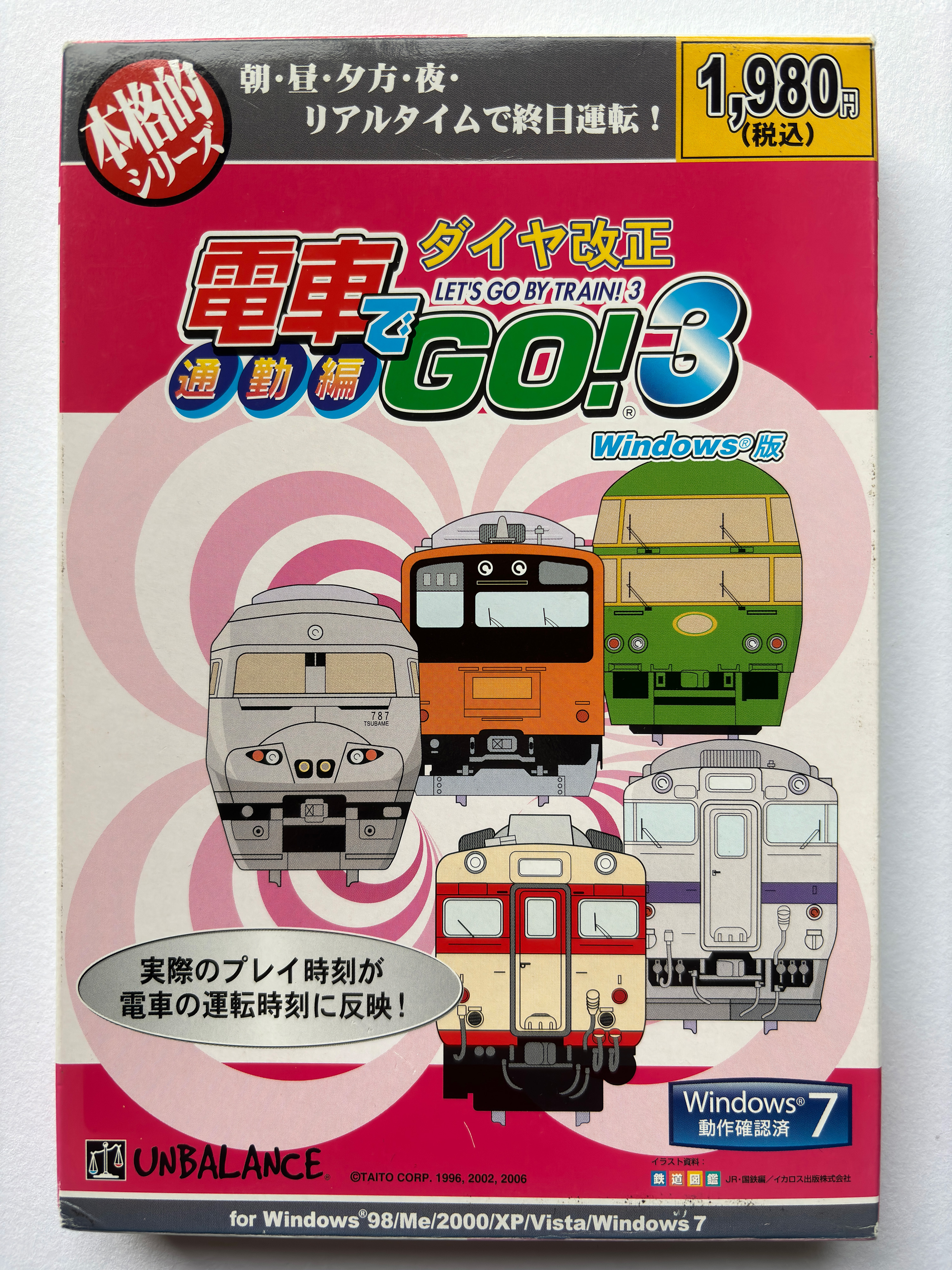
Train driving games, especially on PC, the home of multi-monitor displays and eye wateringly-priced specialist controllers, are usually very serious and realistic. And in many ways Taito’s Densha de Go! 3: Daiya Kaisei is no different. It’s a game for people who honestly pause for a moment to consider whether they want to drive from Tosu to Hakata station in a 787 series train or a KiHa 72, the game accurately reflecting the differences in their handling, weight, and even the sounds they make as they power along the track.
Every new game begins with a short introduction of the train itself, sincerely talking up their power inverters and roomy interiors. This particular version of the game, released on Windows in 2002, featured the raw thrill of revised timetables.
Wow. Great. Surely the sort of thing only of interest to someone with a box full of OO gauge track in a cupboard, a collection of tiny model trains to run on the stuff, and a battered notebook filled with weird numbers.
Well, no. What makes the Densha de Go! series unique is that it takes a hobby that even dice-rolling PC gamers like me assume is ultra-nerdy and turns it into an irresistibly challenging, high-pressure arcade contest against the clock.
Pick a route. Any route. Any time of day. Congrats, you’ve now got 60 seconds—maybe a little more, maybe even a worrying amount less—to reach somewhere you’ve never been before in a vehicle you’ve never driven in your life. You must observe all speed limits, signals (accurate to those used not just on Japan’s railways but that specific part of Japan’s railways), and rail-related laws along the way. Oh and the aim isn’t to get to the next stop as quickly as possible, it’s to get there on time, and then stop in exactly—exactly—the right place at the station.
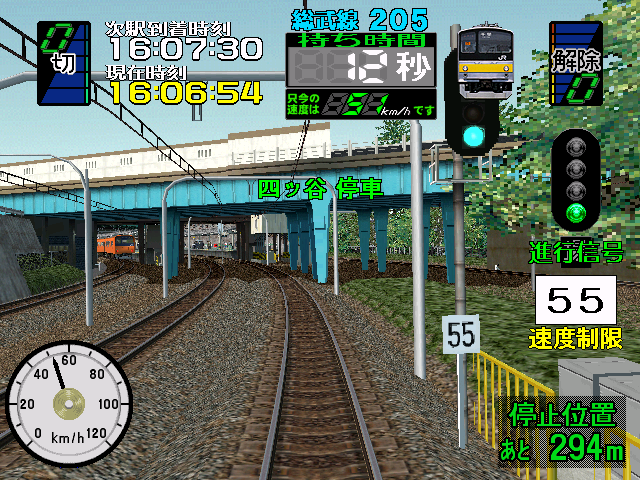
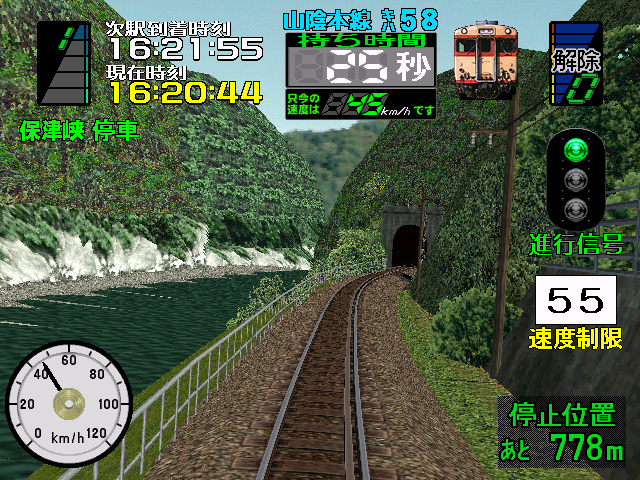
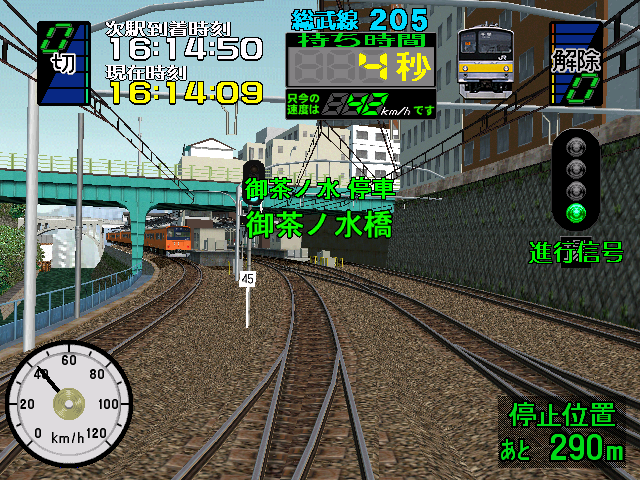
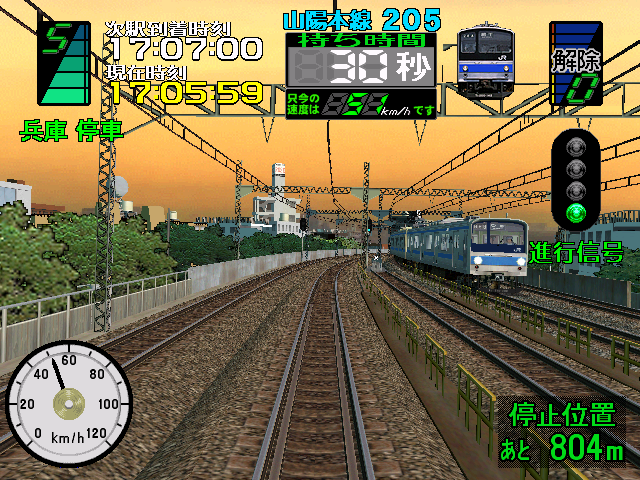
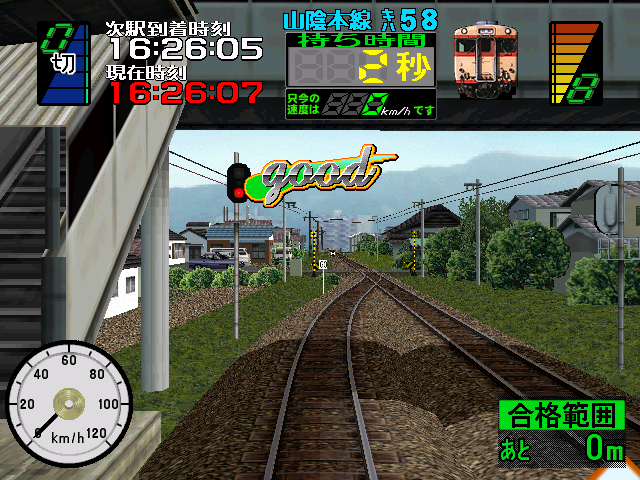
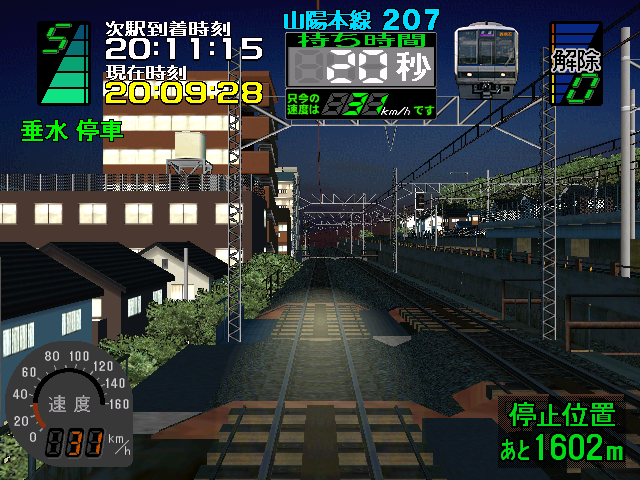
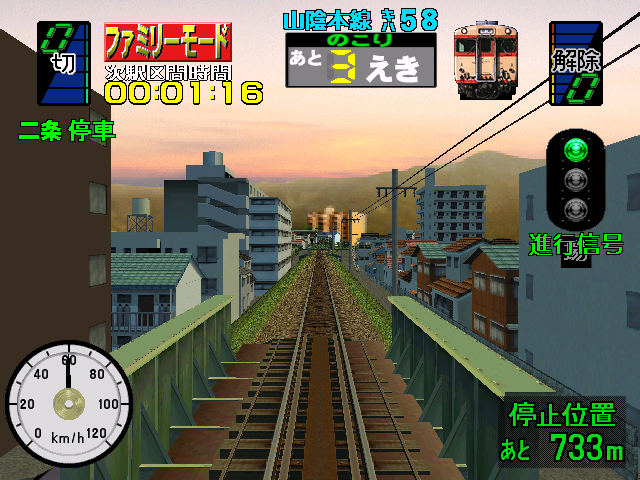
Every mistake is noted and penalised, your already small starting pool of “buffer” time drained whenever you mess up. And you will mess up. 60 km/h in a 45 zone? Penalty. Braked too hard, making passengers wobble? Penalty. Missed the stop by 3 measly metres? Penalty.
Once you’ve got no more seconds left to lose, the only real option left is to not mess up.
It’s a real test of personal prowess, and anyone who has spent their free time trying to avoid Malenia’s Waterfowl Dance or fought their way to the upper tiers of a fighting game’s online ranking can relate to that. The strictness found in earlier Densha de Go!s like this one is (eventually) as rewarding as it is intimidating. Gently applying the brakes to keep a train just under the speed limit on a downhill section, rolling to a stop at precisely the right time, and finally nailing a tricky stretch of track are all satisfying skills that take practice to develop.
There’s a point to running the same route over and over again, to putting in the work: I know the game will always notice, right down to the second and the centimetre, every improvement I make.
Getting to that point doesn’t have to be a tiring trial by train though, if I ever get there at all. Family mode—the default setting—does away with all of the standard game’s nitpicky negatives (which are further magnified in the optional “Master” mode) and time penalties. It doesn’t even trouble its players with speed limits, although the signs still remain by the side of the track. Even a time over simply carries the route on from the next station. It’s the perfect way to get the hang of the game’s unusual controls, where acceleration and braking are handled separately and in clearly defined steps, and to adjust to the pleasant routine of pulling away from the station (wait for the little all-clear light!) and coming to a stop without making everyone fall over because I rushed in too quickly. My rail career isn’t ruined if I come to an agonisingly slow halt just past the boarding platform, 20 seconds too late for it to matter anyway.
The short report card at the end of each segment, covering three important areas—braking, stopping accuracy, and safety—continues this mode’s forgiving theme. The game passes comment on my driving, but makes a point of reframing even the most amateurish runs as encouraging positives. Densha de Go! might say I need to improve on something, rather than say I did it badly. It’s a small change that makes a big difference. Sure, I didn’t get it right this time, but that doesn’t mean the next one won’t be better, and maybe the one after that will be perfect.
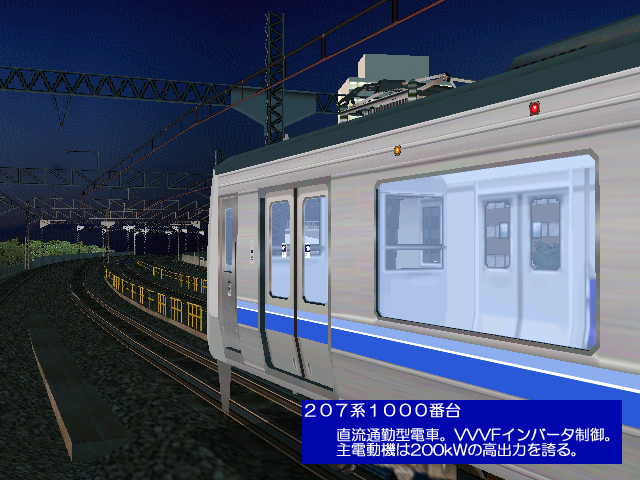
With a bit of practice it becomes clear that every mode’s encouraging, albeit in their own peculiar, detail-oriented way. There are methods to earn precious bonus seconds even when your braking game isn’t up to scratch, such as sounding the horn at the right time before entering a tunnel or when passing a line worker. Turning up exactly on time but a bit off the stopping mark earns a little star on the route chart and a “Good” graphic splashed across the screen at eye level, visual markers of a tough job well done. The game may be quick to punish errors, but it’s just as quick to praise.
Whatever the mode, after a while the experience transforms into something truly terrifying—a genuine love for the subject matter. It’s very easy to end up with a favourite train and enjoy looking out at rambling rivers and fields that stretch to the horizon (well, the end of the game’s draw distance) from your prime seat in the virtual driver’s cab. The contrasting urban areas are interesting, angular, and packed with detail, heavy construction work and ordinary cars waiting at the level crossings as you trundle along.
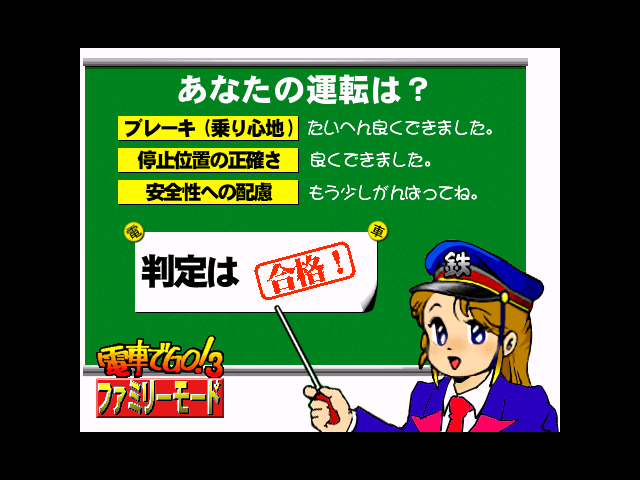
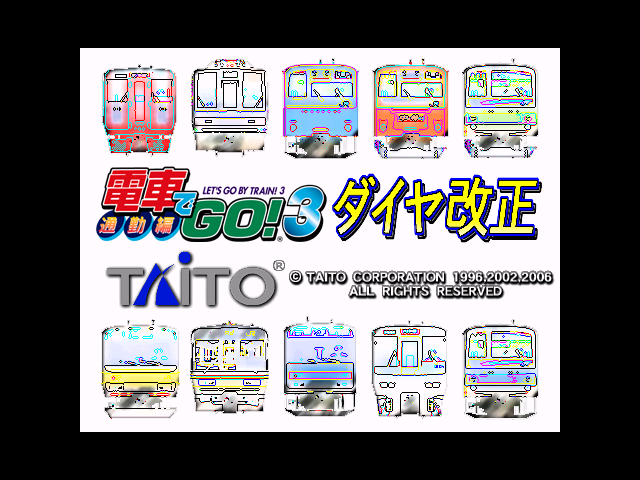
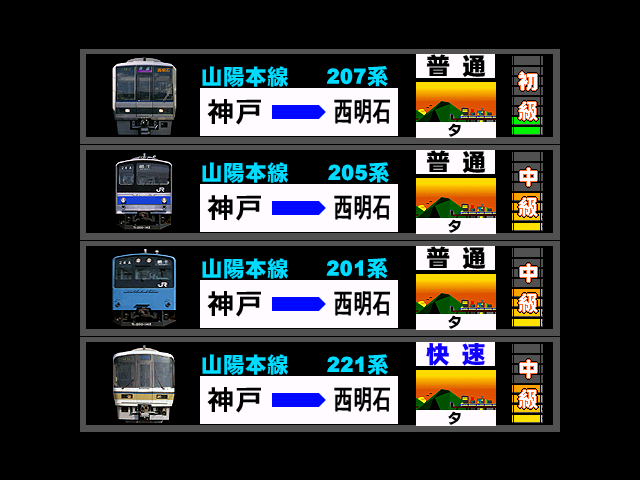
I developed a ridiculous urge to respectfully nod in the direction of other polygonal trains as they passed by in recognition of our shared skills, and I almost wish I wasn’t playing it 22 years too late to participate in the game’s online leaderboards, even though I know I would have either been utterly crushed by everyone else or developed an unhealthy score-stomping obsession with 13-year-old Japanese kids.
A lot of retro import games look very impressive in screenshots but play like the middling RPG and action games they really are once you get past the enticing anime art and the lure of acquiring something “exotic” with a fold-out map in its oversized box. Densha de Go! is the opposite. It looks like something a Certified Dad plays for an hour every weekend while his forgotten mug of tea goes cold.
But it plays like a hardcore gamer’s dream.











